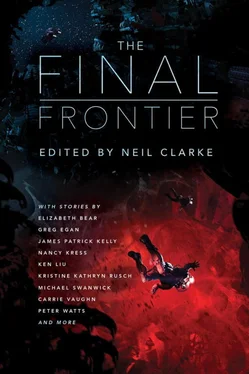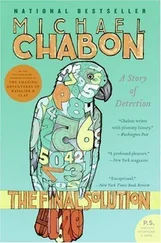Theodora had the uncomfortable feeling of vertigo as every time she performed telemetric control. She guided the repair drone carefully to the drilling probe’s main panel. She felt strangely dissociated with her body when the robot picked the cover and she felt as if it were her arms raising it and putting it aside. There she was. “Oh, not this,” she sighed.
No wonder Dimitri had no success trying to get the probe running again from here. It was no software bug, temporary failure or anything the self-repair systems could handle. Most of the processors were fried and needed replacing. The repair drone didn’t have all of the components. They could send them down during some of the next orbit. But—
She lost her connection to the drone, as Kittiwake disappeared over the horizon from the drone’s perspective, before she could end it herself. She gasped. It felt as if her limb had been cut off. She gulped and tried to concentrate again.
Yes, they could send the parts down. But Theodora feared that although the drone itself had more than sufficient AI for common repairs and had all the blueprints in its memory, it might overlook something else, something an AI would not notice and that might cause future trouble. She’d not be happy if they had to replace the processors again, like it happened once on Triton. She could control the drone from distance again, but there was no chance she could achieve that much precision and look everywhere through telemetry.
Well, they wanted to initiate manned exploration anyway. It would just have to be sooner than expected.
Dimitri watched Theodora’s descent. He knew that she had performed similar procedures many times before—but that never prevented him from worrying.
The view distorted as Kittiwake started losing connection. In another thirty minutes or so, they would be out of range, so Dimitri moved the ship to a stationary orbit above her. The two satellites were operational and deployed on an equatorial and polar orbits would continue to scan the rest of the surface. He could have made them relay stations, but he liked being able to communicate directly with Theodora, her landing module, her rover and the drilling probe. Fewer things could go wrong. And after years spent so far from Earth, they knew that things often went wrong.
He gave the engine command for more thrust and checked on the planned stationary transfer orbit. Everything seemed fine for a while.
Until a red light flashed next to the screen and a warning presented itself.
Theodora was descending through the tunnel in the ice. It was dark except the light from LEDs on her suit and the reflectors from the top of the shaft. Her rope was winding down gradually. She could see the drilling device below now.
The light above seemed faint when she reached the probe. It took her only an hour to get it operational again. She smiled and let the winch pull her up again.
Just as she neared the surface, she heard a noise in the speakers of her suit. “Dimitri?” she spoke. “What is it?”
“Have to… come down…”
She barely understood him through the static.
“Dimitri!”
For a while, she heard nothing. Then the static returned—and after that, Dimitri’s distorted voice. “…have to land.” Cracking and humming. Theodora tried to amplify the sound frantically. “…send you the coordinates… hope it works out…”
A file found its way through the transmission. It was a technical report generated by Kittiwake . Theodora opened it and glimpsed through it quickly. “Oh no,” she whispered.
Dimitri was doing his best to lead the remains of the ship on a trajectory ending with something that would approximate a landing more than a crash.
It was less than twenty minutes from the moment he accelerated Kittiwake to reach the transfer orbit but it seemed like an eternity. During that time, a warning indicated that the main turbine in the ship’s power station was not working properly. He ran a more detailed scan and a moment later, everything was flashing with error reports.
The turbine in the power cycle broke down. It was tested for signs of wearing down regularly, but a hairline crack might have been overlooked in the control. The ship was moving with inertia most of the journey, the crack could have expanded during the deceleration phase and ruptured now, when the engine was working a little more again.
Things could go wrong. And they went wrong. Worse even, one of the blades pierced the coating of the reactor and the heated helium-xenon gas started leaking rapidly. The damage was too much for the automated repair systems. It was still leaking into the space between the coatings.
And the reactor itself was overheating quickly. Once the turbine stopped working, the gas still trapped in the cycle kept getting more and more heat from the MITEE—but couldn’t continue through the cycle and cool down.
It was not critical yet, but would be in another couple of minutes. Dimitri sent all the repair drones to help the built-in repair and emergency systems but could see that it was not enough. He had also shut down the MITEE and all the rods were now safely turned to stop the reaction. It still wasn’t enough. The overheating continued and could lead to an explosion. It could happen in a few minutes if not cooled down quickly.
It was just a way life went. Nothing serious happened in years and suddenly he’s got minutes .
He knew there was only one thing to do. So he gave a command for the valves in the outer reactor coating to open. Then all the gas would leak outside. The ship would be useless without it, but it was the better one of two bad scenarios.
So far, only a minute had elapsed from the breakdown.
In the next few seconds, things went from bad to worse.
“Shit,” exhaled Dimitri as he felt how the Kittiwake started spinning. One of the valves must have been stuck, so that the gas started leaking outside in just one direction. It quickly sent the ship into rotation.
Dimitri tried to compensate it with thrusters on both RCSs, but then Kittiwake shook hideously and then many of the screens went down. He realized what happened.
The rotation was too much. The ship was never constructed for this. There was too much tension in wrong direction… She tore apart.
Still coping with the rotation, he checked the systems. He was right. The engine section was gone. He was lucky that the habitation section was still operating almost normally. There was his chance.
This section’s reaction control system was apparently still working. The RCS’s thrusters were small, but it was all he had.
He tested them with a short blast. Actually working; good. He used them to provide a little more distance from the other remains of the ship and then reviewed his situation more calmly. He had to land if he wanted to live; and he needed to do it quickly, otherwise he’d drift into space with no means of correcting his trajectory.
He smiled rather sadly.
About twenty minutes after the turbine breakdown, Dimitri was now leading the rest of the ship down on Sedna and praying he could actually land instead of crashing.
“Dora?” he called. He hoped she’d pick up the transmission. “Dora, can you hear me? The reactor had a breakdown and the ship tore apart! I’m left with our section’s remains. I have to come down…”
Theodora was driving her rover frantically to the landing site. She could not contact Dimitri, but that didn’t mean anything; the antenna could have been damaged, while most of the ship could be perfectly fine. It’s all right . He is fine .
She wished she could go faster, but as on most ice-rocky bodies, Sedna’s surface could be treacherous. It had far fewer cracks or ridges than Europa or Ganymede and was actually very smooth compared to them, but it was still an alien landscape, not resembling anything on Earth at all. Himalaya’s glaciers were children’s toys compared to Sedna. The perspective was wrong, the measures were wrong, the shadows were wrong; it wasn’t a land fit for human eyes and spatial recognition.
Читать дальше












